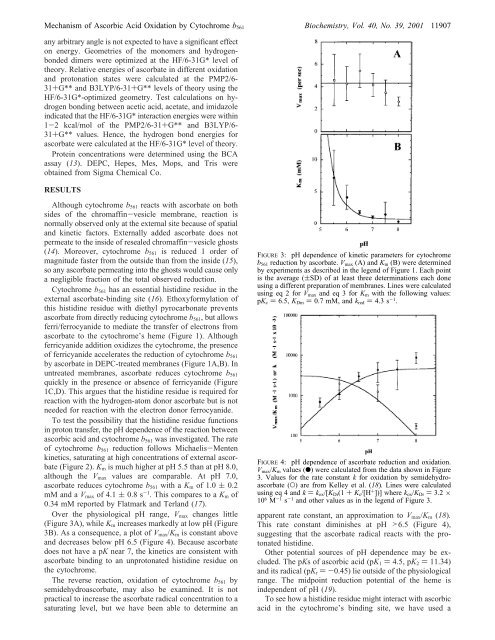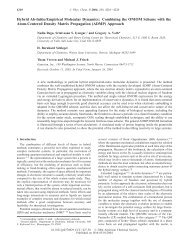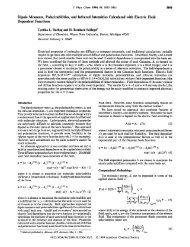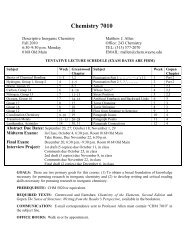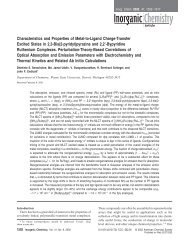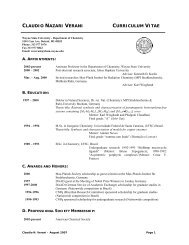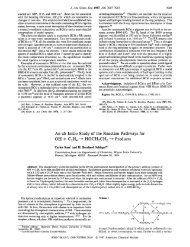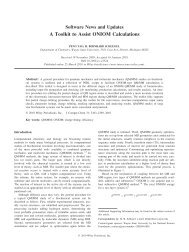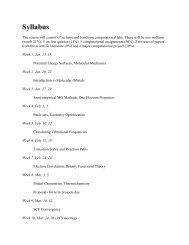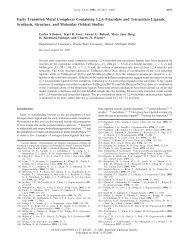Mechanism of Ascorbic Acid Oxidation by Cytochrome b561
Mechanism of Ascorbic Acid Oxidation by Cytochrome b561
Mechanism of Ascorbic Acid Oxidation by Cytochrome b561
You also want an ePaper? Increase the reach of your titles
YUMPU automatically turns print PDFs into web optimized ePapers that Google loves.
<strong>Mechanism</strong> <strong>of</strong> <strong>Ascorbic</strong> <strong>Acid</strong> <strong>Oxidation</strong> <strong>by</strong> <strong>Cytochrome</strong> b 561 Biochemistry, Vol. 40, No. 39, 2001 11907<br />
any arbitrary angle is not expected to have a significant effect<br />
on energy. Geometries <strong>of</strong> the monomers and hydrogenbonded<br />
dimers were optimized at the HF/6-31G* level <strong>of</strong><br />
theory. Relative energies <strong>of</strong> ascorbate in different oxidation<br />
and protonation states were calculated at the PMP2/6-<br />
31+G** and B3LYP/6-31+G** levels <strong>of</strong> theory using the<br />
HF/6-31G*-optimized geometry. Test calculations on hydrogen<br />
bonding between acetic acid, acetate, and imidazole<br />
indicated that the HF/6-31G* interaction energies were within<br />
1-2 kcal/mol <strong>of</strong> the PMP2/6-31+G** and B3LYP/6-<br />
31+G** values. Hence, the hydrogen bond energies for<br />
ascorbate were calculated at the HF/6-31G* level <strong>of</strong> theory.<br />
Protein concentrations were determined using the BCA<br />
assay (13). DEPC, Hepes, Mes, Mops, and Tris were<br />
obtained from Sigma Chemical Co.<br />
RESULTS<br />
Although cytochrome b 561 reacts with ascorbate on both<br />
sides <strong>of</strong> the chromaffin-vesicle membrane, reaction is<br />
normally observed only at the external site because <strong>of</strong> spatial<br />
and kinetic factors. Externally added ascorbate does not<br />
permeate to the inside <strong>of</strong> resealed chromaffin-vesicle ghosts<br />
(14). Moreover, cytochrome b 561 is reduced 1 order <strong>of</strong><br />
magnitude faster from the outside than from the inside (15),<br />
so any ascorbate permeating into the ghosts would cause only<br />
a negligible fraction <strong>of</strong> the total observed reduction.<br />
<strong>Cytochrome</strong> b 561 has an essential histidine residue in the<br />
external ascorbate-binding site (16). Ethoxyformylation <strong>of</strong><br />
this histidine residue with diethyl pyrocarbonate prevents<br />
ascorbate from directly reducing cytochrome b 561 , but allows<br />
ferri/ferrocyanide to mediate the transfer <strong>of</strong> electrons from<br />
ascorbate to the cytochrome’s heme (Figure 1). Although<br />
ferricyanide addition oxidizes the cytochrome, the presence<br />
<strong>of</strong> ferricyanide accelerates the reduction <strong>of</strong> cytochrome b 561<br />
<strong>by</strong> ascorbate in DEPC-treated membranes (Figure 1A,B). In<br />
untreated membranes, ascorbate reduces cytochrome b 561<br />
quickly in the presence or absence <strong>of</strong> ferricyanide (Figure<br />
1C,D). This argues that the histidine residue is required for<br />
reaction with the hydrogen-atom donor ascorbate but is not<br />
needed for reaction with the electron donor ferrocyanide.<br />
To test the possibility that the histidine residue functions<br />
in proton transfer, the pH dependence <strong>of</strong> the reaction between<br />
ascorbic acid and cytochrome b 561 was investigated. The rate<br />
<strong>of</strong> cytochrome b 561 reduction follows Michaelis-Menten<br />
kinetics, saturating at high concentrations <strong>of</strong> external ascorbate<br />
(Figure 2). K m is much higher at pH 5.5 than at pH 8.0,<br />
although the V max values are comparable. At pH 7.0,<br />
ascorbate reduces cytochrome b 561 with a K m <strong>of</strong> 1.0 ( 0.2<br />
mM and a V max <strong>of</strong> 4.1 ( 0.8 s -1 . This compares to a K m <strong>of</strong><br />
0.34 mM reported <strong>by</strong> Flatmark and Terland (17).<br />
Over the physiological pH range, V max changes little<br />
(Figure 3A), while K m increases markedly at low pH (Figure<br />
3B). As a consequence, a plot <strong>of</strong> V max /K m is constant above<br />
and decreases below pH 6.5 (Figure 4). Because ascorbate<br />
does not have a pK near 7, the kinetics are consistent with<br />
ascorbate binding to an unprotonated histidine residue on<br />
the cytochrome.<br />
The reverse reaction, oxidation <strong>of</strong> cytochrome b 561 <strong>by</strong><br />
semidehydroascorbate, may also be examined. It is not<br />
practical to increase the ascorbate radical concentration to a<br />
saturating level, but we have been able to determine an<br />
FIGURE 3: pH dependence <strong>of</strong> kinetic parameters for cytochrome<br />
b 561 reduction <strong>by</strong> ascorbate. V max (A) and K m (B) were determined<br />
<strong>by</strong> experiments as described in the legend <strong>of</strong> Figure 1. Each point<br />
is the average ((SD) <strong>of</strong> at least three determinations each done<br />
using a different preparation <strong>of</strong> membranes. Lines were calculated<br />
using eq 2 for V max and eq 3 for K m with the following values:<br />
pK c ) 6.5, K Dm ) 0.7 mM, and k red ) 4.3 s -1 .<br />
FIGURE 4: pH dependence <strong>of</strong> ascorbate reduction and oxidation.<br />
V max /K m values (b) were calculated from the data shown in Figure<br />
3. Values for the rate constant k for oxidation <strong>by</strong> semidehydroascorbate<br />
(O) are from Kelley et al. (18). Lines were calculated<br />
using eq 4 and k ) k ox /[K Dr (1 + K c /[H + ])] where k ox /K Dr ) 3.2 ×<br />
10 6 M -1 s -1 and other values as in the legend <strong>of</strong> Figure 3.<br />
apparent rate constant, an approximation to V max /K m (18).<br />
This rate constant diminishes at pH >6.5 (Figure 4),<br />
suggesting that the ascorbate radical reacts with the protonated<br />
histidine.<br />
Other potential sources <strong>of</strong> pH dependence may be excluded.<br />
The pKs <strong>of</strong> ascorbic acid (pK 1 ) 4.5, pK 2 ) 11.34)<br />
and its radical (pK r )-0.45) lie outside <strong>of</strong> the physiological<br />
range. The midpoint reduction potential <strong>of</strong> the heme is<br />
independent <strong>of</strong> pH (19).<br />
To see how a histidine residue might interact with ascorbic<br />
acid in the cytochrome’s binding site, we have used a


